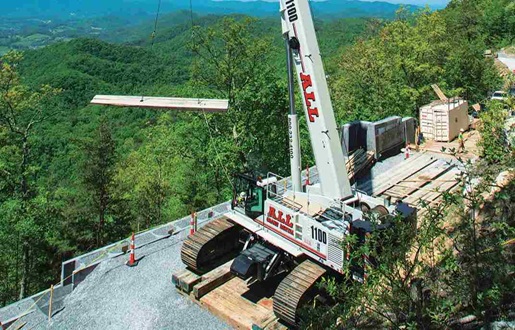
When it comes to choosing between hydraulic and lattice boom crawler cranes, several key factors determine which machine is best suited for your specific project requirements. Understanding the fundamental differences between these two types of crawler cranes is crucial for making an informed decision that improves both project efficiency and cost-effectiveness.
There are a few different factors that can help you figure out which type of crawler is best suited for your job:
- Mobility
- Job length
- Maximum capacity
Crane Mobility
When your job requires frequent repositioning, say from the west bank of a river to the east bank, hydraulic crawler cranes are likely to be a much better fit. Operators can retract their telescopic booms, making it easier to move between lift locations the crawler might not be able to traverse on its own. While both types of cranes can pick and carry, hydraulic crawlers are more compact than lattice crawlers, which makes them more able to maneuver through tighter spaces on congested job sites.
Lattice crawler cranes, while also mobile, require more planning and time for relocation. The heavy-duty lattice boom cannot be retracted like the hydraulic crawler’s telescopic boom. Both types of cranes also offer off-road capabilities for jobsites with difficult terrain.
Job Length
For shorter-duration projects or jobs requiring multiple moves, hydraulic crawler cranes are usually the more economical choice. Their faster setup and teardown times mean less downtime between lifts and locations. These qualities make them particularly valuable for projects lasting days to weeks where crane positioning needs to change frequently.
Lattice crawler cranes are typically more cost-effective for longer-duration projects, such as jobs lasting several months or more. Once they are configured for a specific project, they can work efficiently for extended periods. Their design also typically results in lower maintenance costs over longer projects compared to hydraulic systems.
Lift Capacities
Lattice crawler cranes offer superior lifting capacities compared to hydraulic crawler cranes. The exact capacity depends on the specific machine, but you can generally expect the following range of maximum capacities for each type of crane in the ALL fleet.
- Hydraulic crawler cranes: From 50 to 250 US tons
- Lattice crawler cranes: From 80 to 1,200 US tons
Another advantage of hydraulic cranes is that they can offer high capacities at longer radiuses compared to hydraulic crawlers of similar sizes. Max boom lengths for lattice crawlers can be up to double that of hydraulic crawlers, with jibs and other attachments extending that reach even further. This added length makes lattice crawlers particularly well-suited for heavy lifts at extended reaches, such as large-scale infrastructure projects or power plant construction.
Hydraulic crawler cranes typically have more limited capacities at extended radiuses than lattice crawlers. However, they excel at precision lifting within a smaller radius, making them ideal for applications that don’t require heavier capacities or extended reach.
Need to Invest in Hydraulic or Lattice Crawler Cranes?
The right crane can make a massive difference for the success of your projects. As the largest privately-owned crane rental and sales enterprise in North America, ALL Crane has the fleet of machines available to invest in a crane solution tailored to your exact needs, whether you need hydraulic crawlers, lattice crawlers, or some other heavy lifting machine.
